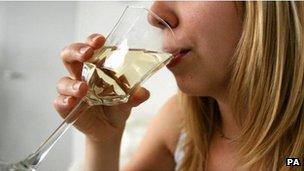How to tackle unsafe drinking
- Published

Drinking over recommended limits can cause harm
Drinking too much is bad for you. But too many people underestimate what is a safe amount of alcohol.
In this week's Scrubbing Up, Dr Nick Sheron, a liver expert at the University of Southampton, explains why we need a blood test to alert people to the harm they could be doing to their body.
We have a serious problem with liver disease in the UK.
If you look at the deaths rates, over the past 30 years or so they have gone down in Europe, but have gone up by 500% in the UK. Practically all of this increase is alcohol related and the most important part of the solution lies in an effective alcohol strategy.
We need to target cheap alcohol, and a minimum price for alcohol will do this
Around a quarter of the UK population are drinking too much, but may not realise it, and GPs have an important role to play here.
Liver disease develops silently. There are no signs or symptoms - the liver has no pain fibres, until disease is very far advanced.
By the time the patient presents to hospital the liver is often very scarred.
Even if the patient stops drinking entirely at this point, it may be too late and many people die of liver complications over the next year or so.
This is partly because doctors do not have the right tools at their disposal.
The current blood test GPs use looks for liver enzymes that show up some types of liver damage, but not the liver scarring process, so they can be falsely reassuring.
Many patients with liver scarring from alcohol have normal liver enzymes, so the likelihood of a GP picking up a problem is small.
For patients admitted urgently to the liver unit in Southampton, in about nine cases out of 10 it comes as a real shock to find they have serious liver disease that has not been picked up previously.
About eight years ago we decided we needed a simple liver-scarring test GPs could use to detect liver disease in patients.
It took us a while, but now we have a simple blood test, which we call the Southampton Traffic Light test.
The result comes in three colours.
Red mean that you have liver scarring and may even have cirrhosis and you probably need to go to hospital for further tests.
Green means we cannot find any liver scarring yet and although the test is not completely perfect, we can say that you are highly unlikely to die from liver disease over the next five years, so there is time to cut your drinking to sensible levels.
Amber means we cannot be absolutely sure, but there is at least a 50:50 chance that you have scarred liver, and there is a significant possibility that you could die of it within 5 years. We find that for most patients this is a pretty good stimulus to stop drinking or at least to cut down to safe levels.
If more GPs used tests like these we could go a long way towards detecting liver disease before it is too late.
- Published29 August 2012